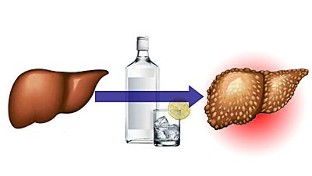The most famous consequence of drinking is liver disease. There are many myths about drinking vodka, beer or wine as less harmful. All alcoholic beverages contain ethanol, which is a potentially toxic substance, so there is no small or beneficial dose.
Even small doses of alcohol can cause negative consequences, but they will last longer.
Why is alcohol harmful to your health?
If you drink excessively frequently, it will not only lead to addiction, but may also be the cause of many organic diseases. Ethanol itself and its components in the production of alcoholic beverages may be harmful to health.
The following organs are the most common organs:
- Liver (alcoholic liver steatosis, hepatitis, cirrhosis);
- Stomach (gastric ulcer, dyspepsia);
- Colon (colon cancer);
- Pancreas (pancreatitis)
Alcohol is highly toxic and addictive. Therefore, it is difficult for many people to quit drinking immediately without consequences. The lethal dose of ethanol is about 8 grams per kilogram of body weight. Therefore, when drinking beer, vodka or beverages, you need to remember the moderate consumption and frequency of consumption. Alcohol is a source of so-called empty calories. Large consumption can cause weight gain (1 g ethanol-7 kcal).
Alcoholic beverages can cause the development of various diseases and exacerbate the symptoms of existing diseases. Therefore, it is worth drinking in small amounts. You can choose beverages with less potential harm. You should also beware of certain compounds that increase the toxicity of ethanol. However, even if these rules are followed, the negative consequences of drinking will sooner or later make them feel. The effect of alcohol on the body depends on many factors. What matters is the type and amount of ethanol consumed, gender, genetic factors, time and route of consumption, type of medication used, and overall health. Similarly, the effectiveness of alcoholism treatment also depends. Simultaneous drinking and smoking have extremely harmful effects on the body. The close connection between alcohol and development has been proven: People who drink alcohol have a 30% increased risk of these tumors. At that time, if alcohol was used in combination with smoking, the risk would increase threefold. Drinking and smoking at the same time will increase the negative effects of drinking and severe hangovers. One of the common mistakes in the development of a hangover is drinking on an empty stomach. This will speed up the absorption of alcohol and cause an increase in hangover symptoms the next day. For example, various flavoring agents used to prepare beverages and to mix multiple types of alcoholic beverages also contribute to hangovers. After consuming high-quality vodka, the hangover is minimal. Ethanol poisoning may also occur when alcohol is abused. The symptoms are: Numerous scientific studies (from different centers around the world) report that very small amounts of alcohol have beneficial effects on the function of individual organs. A small amount of alcohol is between 20 to 40 grams of pure ethanol. It can be said that this is: Suggestion should not be regarded as an incentive to encourage the consumption of alcoholic beverages, nor should it be regarded as daily consumption. It should be remembered about the negative consequences of drinking, even a small amount of alcohol can lead to drug addiction. Many beer and wine drinkers may be tricked into researching the so-called safe alcohol content. A reasonable daily dose has been approved. In theory, this will not have a negative impact on the human body. For women, the daily alcohol content is 20 grams, which is equivalent to a small can of beer or a glass of wine. Conversely, for men, 40 grams of alcohol are consumed every day. These restrictions assume no more than 5 consumption per week. However, even these amounts can lead to addiction and severe health hazards. It should be pointed out that women are more likely to indulge in alcohol than men. They also have a slower metabolic process and can abstain from alcohol. Women consume the same amount of alcohol, and the concentration in the blood is higher than that of men. It doesn’t matter what alcohol everyone drinks or how much alcohol they drink. Regardless of whether the dose exceeds the recognized safe dose, it may still cause disease and drug addiction. They say it is never too late to stop drinking, but the sooner you drink, the better. Therefore, its negative impact on the whole body can be avoided. A large number of studies have shown that consuming a small amount of alcohol every day will increase the so-called good HDL cholesterol content. HDL particles are more effective than bad cholesterol (LDL). This is considered the only way to eliminate cholesterol in the body. It should be pointed out here again that the effect of alcohol is an exception, and it is only used in small doses. A small amount of alcohol will not affect total cholesterol. On the contrary, according to this study, excessive drinking can lead to an increase in cholesterol content parameters. You can usually learn about the health benefits of drinking and beer. In fact, they contain certain substances that have a positive effect on the body. For example, quercetin and resveratrol present in red wine have beneficial effects on the heart and vascular system. These are the so-called antioxidants However, other most unsafe foods are also sources of antioxidants: red grapes, berries, apples, and nuts. The negative consequences of drinking are much more than that. Wine contains 8. 5-18% ethanol. The calorie content of wine depends on its type. Sweet wine has the most calories (about 94-104 kcal per 100 grams). Dry wine can provide the least calories (65-68 kcal per 100 grams). Wine contains: Red dry wine is the least harmful, low-calorie, and most antioxidant. Despite the high content of many valuable compounds, wine is an alcoholic beverage containing pure ethanol. This means that even drinking in this form can have negative consequences. The alcohol content in beer is very different-from 0. 2 to 9-10%. Of course, beer has about 49 kcal per 100 grams, while dark beer has more calories because it has about 68 kcal per 100 grams. Beer especially contains antioxidants and B vitamins, magnesium, potassium, and phosphorus. You can find a lot of information about the beneficial effects of beer on the urinary system. But beer is also a source of ethanol. High-quality vodka, liqueur, and brandy contain the most ethanol -15% to 80%. They are also high in calories, about 220 kcal per 100 grams of vodka. Regardless of the lowest dose of alcohol consumed, it still has a devastating effect on the entire body. Don't mistake the facts about the benefits of alcoholic beverages. Alcohol is absolutely unnecessary and sometimes even dangerous to the function of organs and systems. The treatment of alcoholism is a very complicated and usually long process, requiring special efforts from patients, relatives and medical staff. The negative consequences of drinking are far more serious than the brief moments after getting drunk. What determines the harm of alcohol?

Safe Drink-What do you mean?
Can alcohol play a positive role?
How many calories and what ingredients do alcoholic beverages contain?

























